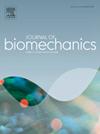新型颈部外部负荷测力计的可靠性。
IF 2.4
3区 医学
Q3 BIOPHYSICS
引用次数: 0
摘要
Cervistab 是一种电动气动装置,可在生态橄榄球姿势(即类似于球场上的姿势)下产生屈曲推力加载事件,以评估颈部伸肌对屈曲扰动的反应。这种反应对于预防橄榄球运动中的头颈部损伤非常重要,但文献中明显缺乏经过验证的设备。本研究测试了这一新设备的可靠性,该设备旨在研究颈部伸肌对屈曲头部推力加载事件的反应。12 名健康志愿者接受了 Cervistab 的测试/重测方案。测试者体验了推力加载事件,对伸肌的预压分别为其最大自主等长伸展力量的 50% 和 20%。对肌肉机械潜伏期、非反射和反射的力量发展速度进行了两次测量,每次间隔 7 天。可靠性通过类内相关系数(ICC)、变异系数(CV)以及布兰德和阿尔特曼图形方法进行评估。在两种预负荷条件下,肌肉机械潜伏期均显示出良好的 ICC 值(0.81 至 0.88)和良好的 CV 值(3.5%)。非反射和反射发力率显示出良好的可靠性,ICC 为 0.78 至 0.89,中等 CV 值为 8.5% 至 14.5%,具体取决于预负荷条件(分别为最大等长伸展收缩的 20% 和 50%)。布兰德和阿尔特曼图显示没有明显的固定偏差或比例偏差。总体而言,使用 Cervistab 进行测量的可靠性良好。Cervistab 可用于提高我们对影响颈部稳定性的神经机械因素的认识,帮助预防头颈部损伤,并为头部或颈部损伤后重返赛场的决定提供指导。本文章由计算机程序翻译,如有差异,请以英文原文为准。
Reliability of a novel neck external loading dynamometer
Cervistab is an electro-pneumatic device that produces flexion push-loading events in an ecological rugby position (i.e. similar to on-pitch position) to assess neck extensors muscle response to a flexion perturbation. This response is important for preventing head/neck injuries in Rugby, however there is a clear lack of validated devices in the literature.
This study tested the reliability of this new device designed to investigate the extensor neck muscle response to flexion head push-loading event. Twelve healthy volunteers were tested with Cervistab in a test/retest protocol. Participants experienced push-loading events with preloading on extensors muscles at 50 % and 20 % of their maximum voluntary isometric extension strength. Muscle mechanical latency, non-reflex and reflex rates of force development were measured twice, 7 days apart. Reliability was assessed by intraclass correlation coefficient (ICC), coefficient of variation (CV), and the Bland and Altman graphical approach.
For both preloading conditions, muscle mechanical latency showed good ICC values from 0.81 to 0.88 and good CV (3.5%). Non-reflex and reflex rates of force development showed good reliability with ICC ranging from 0.78 to 0.89, and moderate CV values ranging from 8.5% to 14.5%, depending on the preloading condition (20% and 50% of maximal isometric extension contraction respectively). Bland and Altman plots showed no significant fixed or proportional bias.
Overall, the reliability of measurements obtained with Cervistab is good. Cervistab can be used in practice to improve our understanding of the neuromechanical factors that influence neck stability, to help prevent head/neck injuries and to guide the decision to return to play after a head or neck injury.
求助全文
通过发布文献求助,成功后即可免费获取论文全文。
去求助
来源期刊

Journal of biomechanics
生物-工程:生物医学
CiteScore
5.10
自引率
4.20%
发文量
345
审稿时长
1 months
期刊介绍:
The Journal of Biomechanics publishes reports of original and substantial findings using the principles of mechanics to explore biological problems. Analytical, as well as experimental papers may be submitted, and the journal accepts original articles, surveys and perspective articles (usually by Editorial invitation only), book reviews and letters to the Editor. The criteria for acceptance of manuscripts include excellence, novelty, significance, clarity, conciseness and interest to the readership.
Papers published in the journal may cover a wide range of topics in biomechanics, including, but not limited to:
-Fundamental Topics - Biomechanics of the musculoskeletal, cardiovascular, and respiratory systems, mechanics of hard and soft tissues, biofluid mechanics, mechanics of prostheses and implant-tissue interfaces, mechanics of cells.
-Cardiovascular and Respiratory Biomechanics - Mechanics of blood-flow, air-flow, mechanics of the soft tissues, flow-tissue or flow-prosthesis interactions.
-Cell Biomechanics - Biomechanic analyses of cells, membranes and sub-cellular structures; the relationship of the mechanical environment to cell and tissue response.
-Dental Biomechanics - Design and analysis of dental tissues and prostheses, mechanics of chewing.
-Functional Tissue Engineering - The role of biomechanical factors in engineered tissue replacements and regenerative medicine.
-Injury Biomechanics - Mechanics of impact and trauma, dynamics of man-machine interaction.
-Molecular Biomechanics - Mechanical analyses of biomolecules.
-Orthopedic Biomechanics - Mechanics of fracture and fracture fixation, mechanics of implants and implant fixation, mechanics of bones and joints, wear of natural and artificial joints.
-Rehabilitation Biomechanics - Analyses of gait, mechanics of prosthetics and orthotics.
-Sports Biomechanics - Mechanical analyses of sports performance.
 求助内容:
求助内容: 应助结果提醒方式:
应助结果提醒方式:


